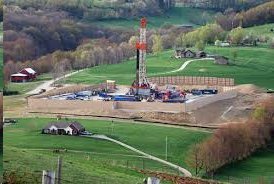Methane escapes from natural gas wells even before fracking, new direct measurements from airplane flyovers show
From an Article by Stephanie Ogburn, ClimateWire, E & E Publishing, April 15, 2014
A new study has found that a small number of gas wells are releasing significant quantities of methane into the air even before they are hydraulically fractured, or fracked.
The paper, published in the journal Proceedings of the National Academy of Sciences, is the result of measurements of methane made by flying an airplane over parts of the Marcellus Shale.
The researchers detected a “significant regional flux” of methane, a greenhouse gas with about 30 times the warming potential of carbon dioxide over a 100-year period, coming from an area of gas wells in southwestern Pennsylvania.
“Basically what we observed was very high concentrations in a particular region,” said Paul Shepson, a professor of atmospheric chemistry at Purdue University and an author of the study. On two days of airplane flights over the area, the research team detected high concentrations of methane in the atmosphere.
Tracking methane back to the source
While flying, researchers followed those plumes of methane back to individual well pads, where they circled the pads to verify that those were the methane sources. Later, members of the research team worked to understand what processes were occurring at those particular well sites. To their surprise, the researchers learned that the wells had not yet been fracked and were not producing gas.
“The methane emissions from the gas wells … are surprisingly high considering that all of these wells were still being drilled, had not yet been hydraulically fractured, and were not yet in production,” the paper reports.
Typically, during the drilling process, methane emissions are estimated to be between 0.04 and 0.3 gram of methane per second per well. The researchers measured emissions rates of 34 grams of methane per second—100 to 1,000 times greater than those estimates. These high emissions were only found in 1 percent of the wells surveyed, however.
This finding lends additional credence to the idea that a small subset of wells, drilling processes and equipment is probably responsible for a large percentage of the emissions from gas drilling.
A ‘fat tail’ of a few leaky wells
This is often referred to as the “fat tail” or “super-emitter” problem, that just a small subset of wells or pieces of equipment is responsible for the majority of the leaks from the natural gas system (ClimateWire, Feb. 14).
Additional evidence for this idea of super-emitters has been reported in other studies, said Steven Hamburg, chief scientist at the group Environmental Defense Fund, which is spearheading a set of studies on leaks from the natural gas supply chain. “I think everything we have seen so far—but we still have a lot of studies to release—;suggests that fat tails are real,” Hamburg said.
Shepson and his co-authors suggest that the reason for high emissions from those wells was either the fact that drillers encountered methane from shallow coal pockets they found that was released to the surface, or that the wells were drilled using a method called underbalanced drilling, which allows fluids and gas to come up to the surface during the drilling process.
In late March, the Obama administration released guidance directing U.S. EPA to address methane emissions from the oil and gas industry, after a number of studies measuring emissions from the air, known as “top-down” measurements, showed that the agency’s emissions estimates for the industry were too low (ClimateWire, March 31). The agency is expected to release white papers soliciting information from independent experts on the topic as early as this week. In the fall, it is expected to decide whether to develop additional regulations on oil and gas methane sources.
Balancing the findings of such top-down studies with the “bottom-up” inventories done by EPA, in which components and processes are estimated to leak at certain rates and then essentially added up, is a perennial challenge. EDF’s Hamburg said a study sponsored by his group is currently looking at this very issue and is conducting both bottom-up and top-down estimates of emissions in the same location and trying to reconcile them.
Ultimately, both types of studies are needed to determine emissions, he said. “It’s not an ‘either-or’; it’s a ‘both-and,’” Hamburg said.

